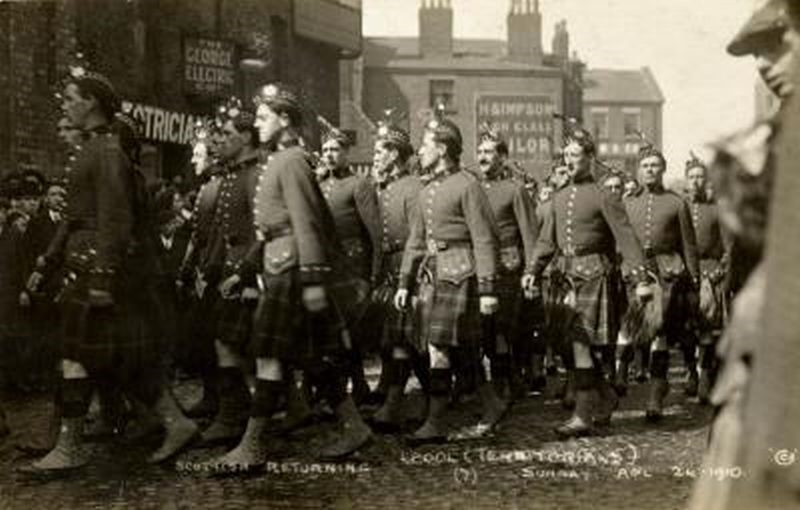The Liverpool Scottish Regiment
Due to work and marriage, my dad (from Oban) was living in Liverpool, then a big Irish centre. My mum was Irish. I was baby knapped from Connel (Oban) at an early age, that’s another story. The Liverpool Scottish, known as “the Scottish”, in the later half of the 19th century under threat of invasion by the French (again!) the Liverpool Scottish Rifle Volunteers (XIXth Lancashire) came into being. In 1900 the Liverpool Scottish was formed in response to the Boer War. A detachment saw service with the 4th Service Company of the Gordon Highlanders. The First World War forms the best recorded periods of the Regiments history as the battalion was one of the first to arrive in Flanders and later raised two further battalions. Due to the relatively high number of educated men in the ranks a number of diaries, paintings and other memorabilia from both officers and the lower ranks exist. Service in the First World War was extensive and the Liverpool Scottish was one of the first battalions to arrive on the western front when it deployed in November 1914. Approximately 1,000 of more than 10,000 men who served with the Scottish died during the war. The first major battle of the Scottish during the war was on 16 June 1915 in what is officially known as “The First Action at Bellewaarde”, which was designed to pin down German reserves while other Allied forces were engaged elsewhere. The action is known to the Liverpool Scottish as the “Battle of Hooge”. Hooge is a village a few miles East of Ypres in Belgium. The unit’s most acclaimed soldier during the war was Captain Noel Godfrey Chavasse, who was awarded two Victoria Crosses whilst attached from the Royal Army Medical Corps. Sergeant Albert Baybut, Chavasse’s Medical Orderly, is technically the most highly decorated soldier in the history of Liverpool Scottish due to Chavasse’s parent unit actually being the Royal Army Medical Corps (RAMC). Baybut would receive a Distinguished Conduct Medal, and Bar, together with the Military Medal for his actions alongside Chavasse during World War I. Chavasse remains one of only three people to have been awarded the VC twice, and the only recipient from the Liverpool Scottish.
1920, the Liverpool Scottish formalised its’ relationship with the Queen’s Own Cameron Highlanders and transferred in 1937 to become the regiment’s second territorial battalion. In comparison to the densely urbanised region that the King’s Regiment encompassed in north-west England, the Cameron Highlanders area of recruitment in the Highlands was sparsely populated. Although it had its’ numerical designation omitted, the battalion’s identity was preserved and headquarters at Fraser Street, Liverpool were retained. During a royal visit to Liverpool in 1938, George VI presented the battalion with new colours at Everton Football Club’s Goodison Park stadium. 1937 the battalion became part of the The Queen’s Own Cameron Highlanders – where it would remain until 1992. During the 1939-45 war, the 1st Battalion of The Liverpool Scottish remained in Great Britain as a training battalion providing many reinforcements for the Queen’s Own Cameron Highlanders battalions (and other Highland regiments) on active service overseas. The 1st. Battalion served in Gibraltar from 1945 to 1947. The 2nd. Battalion, The Liverpool Scottish, supplied reinforcements for Highland regiments. In April 1967, The Liverpool Scottish reformed as V (The Liverpool Scottish) Company, 51st. Highland Volunteers AVR II with battalion HQ in Perth.
How strange this now is … my dad was in this regiment during the second world war, and now I am also based in Perth.
In 1999 as a result of the reorganisation The Liverpool Scottish company was disbanded. With fifty Liverpool Scottish soldiers, retaining their distinctive bonnet badge, their highland dress and their regimental customs, formed part of a new infantry battalion, The King’s and Cheshire Regiment. From July 2006 the King’s and Cheshire Regiment was reorganized and the King’s Regiment companies (A and C Company), including the Liverpool Scottish element joined the 4th Battalion The Duke of Lancaster’s Regiment (King’s, Lancashire and Border). Any Highland military unit has a proud association with the bagpipes and the Liverpool Scottish were no exception. A number of tunes and exhaustive section on pipe banners and their heraldry are in the museum. My dad, as mentioned, was in the regiment, he and his mates then were sent to Burma in WWII where he fought in the jungles against the Japanese, I have his medals to prove this. My dad was my hero, he died in an accident at work when I was two years old. Everything I have done since, up here in Scotland is in his memory and dedicated to him. I take guests on tour to Oban as often as possible, being born there has placed an indelible anchor in me which I try and share with as many people as I can.
The Regimental Museum Trust is responsible for the Regimental Museum, established in 1979 to protect the collection of artifacts acquired since the foundation of the 8th (Scottish) Volunteer Battalion, The King’s (Liverpool Regiment) in 1900. This and its’ successor units are generally known as The Liverpool Scottish. Associated with the Army Museum Ogilby Trust and the Association of Independent Museums. Liverpool Scottish Regimental Museum Trust (Reg Charity 277953). A deeply personal blog by Paul McLean, Perth 2019.

